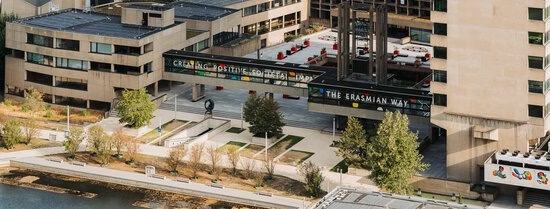University teachers who want to know more about how best to design their international courses can now download the second edition of UNIC’s Handbook on Physical and Virtual Mobility. Jeroen Jansz from the Erasmus University Rotterdam (EUR) and Astrid Tan from the Ruhr University Bochum explain what the handbook and UNIC are all about.
Teaching international students in your course can be different from teaching local students only. “Some teachers think they have to design a completely new course, but that is not the case,” says Jeroen Jansz, professor of communication and media and academic director of the Community for Learning & Innovation at EUR.
Change small things
“In fact, you can start by changing very small elements in your courses,” adds Astrid Tan, who is doctor of philosophy and project coordinator at the Centre for Teaching and Learning at the Ruhr University Bochum in Germany. However, both of them also agree: “Teachers sometimes need a bit of support and help with this.”
Both Tan and Jansz are involved in UNIC, an alliance of ten European universities, and both are specialised in teaching in an international context. UNIC, the European University of Cities in Post-Industrial Transition, was established in 2020 and is co-funded by the European Union’s Erasmus+ Programme. EUR plays a key coordinating role in UNIC and hosts the secretariat of the alliance. “UNIC provides an organisational approach for students who want to study in other European countries and for academics who want to work together with international colleagues,” Tan explains.
Explain more and be more flexible
UNIC published the Handbook on Physical and Virtual Mobility, the first edition in 2021 and the revised and expanded edition last September. It’s written for university teachers looking for inspiration in designing international teaching. The practical tips and checklists help to enrich existing courses.
Asked what small elements you can change to adjust your course to international students, Tan, who coordinates the handbook, says: “Avoid misunderstandings for example. It helps if teachers are aware that international students often need a bit more explanation about why the teacher does certain things – things that are obvious to the teacher and the local students.”
Another element you can change is trying to be more flexible, adds Jansz, who works with students from 74 different nationalities in his Media & Communication department. He has noticed that some teachers see international students as lacking certain knowledge and therefore think they can't enrol in a master's programme. “Some subjects, such as statistics, are taught in very different ways around the globe. You need to take that into account.”
“They’re dealing with different issues and are trying to adapt to these changes in their own way”
Jeroen Jansz
Economic transitions
In addition to Rotterdam and Bochum, the universities that make up UNIC – the European University of Cities in Post-Industrial Transition – are located in Bilbao, Cork, Istanbul, Liège, Łódź, Malmö, Oulu and Zagreb.
These cities have one thing in common: all ten are undergoing major economic transitions, explains Jansz. “They’re dealing with different issues and are trying to adapt to these changes in their own way.” Post-industrial challenges involve for example a high unemployment rate, social inequalities or an increasing demand for new professions or qualifications, or can even result in brain drain like in Croatia.
Virtual collaboration
Exchange doesn’t have to mean literally getting on a plane to meet in person. UNIC, including the handbook, is very much focused on creating opportunities for virtual collaboration and exchange between academics and students. Apart from environmental reasons, many of the students in the cities involved simply can’t afford to travel to another country and live there to study. Janzs: “These cities in transition are also poor cities.” So the handbook also gives teachers ideas on how to integrate virtual international collaboration in their courses.

Through UNIC virtual international cooperation seems to be easier to organise for both students and researchers. For example, law students from Koç University in Istanbul, Turkey recently collaborated with law students from the University of Liège in Belgium in an international law course. Their teachers collaborated to prepare a common task for them, analysing European Court of Justice cases resulting in a common statement.
Enjoyment and efficiency
“For students, this is really a new experience,” says Jansz, “but the teachers also report that they benefit a lot from this teaching collaboration.” He is keen to point out: “This way of working is also very enjoyable and very efficient.” He is referring to the fact that in the past, this kind of collaboration between academics used to happen mostly during physical conferences and while everyone was usually very enthusiastic at that moment, a lot of effort had to be put into creating a follow-up. “Now we already have the virtual connections, we can easily find each other.”
More than 1200 teachers have already downloaded the handbook. In addition to the checklists, the handbook contains interesting stories from the field, examples of what teachers are already doing at partner universities. Tan and Jansz also recommend that teachers sign up for the UNIC’s ‘Teaching the Teachers Trainings’ virtual workshops.

City councils
It is not only students and researchers who work together in UNIC, Jansz points out: “It’s also very important for UNIC to work with the city councils.” To this end, a network of CityLabs has been developed in which students, researchers and cities work together on topics such as the economy, health, mobility and diversity.
“We want to better connect the world of science with the citizens to solve the problems of cities and universities,” Tan concludes. “Students, researchers and society will all benefit.”
- Professor
- More information
This article is written by: Thessa Lageman.
- Related content

